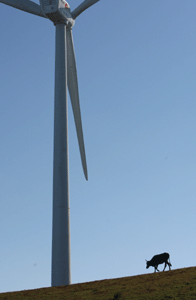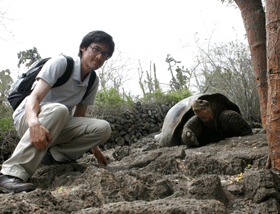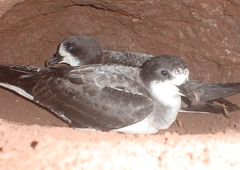Galapagos Wind
Air Date: Week of May 16, 2008

One of San Cristobal wind project's three turbines; together they supply half of the islands’ energy. (Courtesy of San Cristobal Wind Project)
Seven years after a major oil spill in the Galapagos, the government of Ecuador has held true to its word to cut down on the number of diesel imports to the archipelago. The country just inaugurated its first wind farm on San Cristobal island in the Galapagos, and it’s one of the world’s largest wind-diesel hybrids. Spectrum Radio’s Erico Guizzo visited the San Cristobal Wind Project and has our report.
Transcript
GELLERMAN: The Galapagos is a wind-swept archipelago, famous for inspiring Charles Darwin’s theory of evolution. Now even the wind there is evolving, thanks to a new generation of wind power technology. On the island of San Cristobal, you’ll find a new breed of wind turbine that supplies half of the island’s electricity. Spectrum Radio’s Erico Guizzo traveled to the Galapagos and brought back our report.
[BOAT ENGINE HUMMING]
GUIZZO: San Cristóbal is part of a group of small islands in the Pacific that form one of the most exquisite places on earth: the Galapagos archipelago. Every year, more than one hundred thousand tourists come to the Galapagos to get close to its extraordinary fauna: to snorkel with hammerhead sharks, hang out with giant tortoises, or bask on the beach with sea lions.
[SEA LIONS BARKING ON THE BEACH]
GUIZZO: Charles Darwin visited the Galapagos in 1835. The unique creatures he found here captured his imagination and helped him realize that species evolve by means of natural selection. Nature loving visitors now flock to the islands in hopes of seeing what Darwin saw. But today the Galapagos, located about seven hundred miles off Ecuador, is a very different place. Tourism has increased rapidly, and so has the local population, which now is more than twenty thousand. There are also lots of hotels, shops, restaurants and vehicles.
[MOTORCYCLE ENGINE STARTS UP; KIDS TALKING]
GUIZZO: The tourism and population boom brought a higher demand for electricity. Until recently, the islands relied entirely on diesel generators. The fuel for the generators, and also for boats and vehicles, arrives by oil tanker from mainland Ecuador. Seven years ago, a tanker ran aground and spilled 150,000 gallons of fuel into San Cristóbal’s harbor. Since then, the government of Ecuador intensified efforts to free the Galapagos from fossil fuels. The government teamed up with the United Nations Development Program and the e8, an international consortium of electricity companies, to launch the San Cristóbal Wind Project.
[WIND BLOWING]
TOLAN: This project is called a high penetration wind-diesel hybrid system.
GUIZZO: Jim Tolan is an American engineer and one of the project managers. He says that the goal of the ten million dollar project is to supply half the island’s electricity, on average, with a two point four megawatt wind farm.

(Photo: Diego Añazco)
TOLAN: In the high wind periods, we might actually be putting eighty percent of the grid energy from wind; it’s a very high percentage.
[TURBINE BLADES WHIRRING]
GUIZZO: The three wind turbines perch atop a hill on the highlands of San Cristóbal, ten miles from town. The steel towers stand as tall as fifteen storey buildings and hold three-bladed rotors. Through the dense fog, it’s difficult to make out the blades, each about the length of a Jumbo 747 wing.
[TURBINES WHIRRING]
GUIZZO: Tolan leads me through a small door into turbine number one. We put on safety harnesses and hook them to a steel cable to climb a narrow ladder that stretches all the way to the top of the tower.
[HARNESSES CLANKING ON STEEL CABLE]
GUIZZO: Inside this giant white walled tube, with the fluorescent lights flickering and electronic equipment beeping, it's like being in a spaceship.
[ELECTRONIC BEEPING]

Reporter Erico Guizzo communes with a tortoise. (Photo: Erico Guizzo)
The San Cristobal wind project presented many technical and logistical hurdles to Tolan and his team, including how to bring construction equipment and materials to this tiny island. But in the end, what proved more challenging were the environmental aspects of the project.

The San Cristobal wind project team had to show that their wind farm would not disturb the nesting grounds of the endangered seabird, the Galapagos petrel. (Courtesy of San Cristobal Wind Project)
Eventually studies concluded that the turbines presented little threat to the petrel and that transmission lines should be buried to minimize obstructions to the birds’ flight path. San Cristóbal residents soon were on board with the project, and are now proud to be the first place in the Galapagos, and all of Ecuador, to use wind power. Patricio Andrade heads Elecgalapagos, the publicly owned utility. He says the new system is a big step for the archipelago.
[ANDRADE SPEAKING SPANISH]
TRANSLATION VOICE OVER: Many years ago, we had to use oil lamps here, in the rural areas for example. Now we will have a hybrid wind diesel system! Twenty, thirty years ago, at least for me, this was not something I would even dream of!
[FOOTSTEPS ON GRAVELLY TRAIL; BIRDSONG]

(Courtesy of San Cristobal Wind Project)
[SEA LIONS BARKING; BIRDSONG]
GUIZZO: For Living on Earth, I’m Erico Guizzo.
GELLERMAN: Our story about the Galapagos wind farm comes to us courtesy of Spectrum Radio, the broadcast edition of IEEE Spectrum, the magazine of technology insiders.
Links
Erico Guizzo’s IEEE Spectrum magazine article “Wind Power in Paradise”
Living on Earth wants to hear from you!
Living on Earth
62 Calef Highway, Suite 212
Lee, NH 03861
Telephone: 617-287-4121
E-mail: comments@loe.org
Newsletter [Click here]
Donate to Living on Earth!
Living on Earth is an independent media program and relies entirely on contributions from listeners and institutions supporting public service. Please donate now to preserve an independent environmental voice.
NewsletterLiving on Earth offers a weekly delivery of the show's rundown to your mailbox. Sign up for our newsletter today!
 Sailors For The Sea: Be the change you want to sea.
Sailors For The Sea: Be the change you want to sea.
 The Grantham Foundation for the Protection of the Environment: Committed to protecting and improving the health of the global environment.
The Grantham Foundation for the Protection of the Environment: Committed to protecting and improving the health of the global environment.
 Contribute to Living on Earth and receive, as our gift to you, an archival print of one of Mark Seth Lender's extraordinary wildlife photographs. Follow the link to see Mark's current collection of photographs.
Contribute to Living on Earth and receive, as our gift to you, an archival print of one of Mark Seth Lender's extraordinary wildlife photographs. Follow the link to see Mark's current collection of photographs.
 Buy a signed copy of Mark Seth Lender's book Smeagull the Seagull & support Living on Earth
Buy a signed copy of Mark Seth Lender's book Smeagull the Seagull & support Living on Earth

